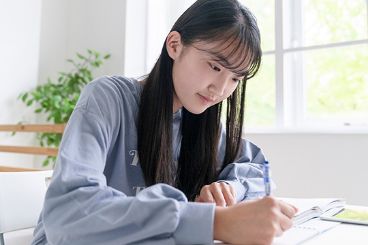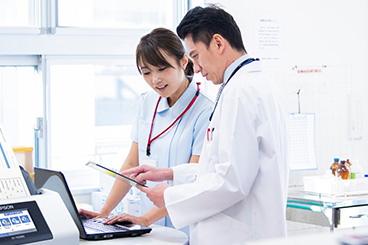Let's tackle social challenges through innovation with Epson!
Medical DX enables task shifting for outpatient work
Cross-system integration with patient data in the cloud can be tedious, but new solutions help centralize patient data in electronic medical records
- Poke-sup, developed using Epson Connect API, semi-automates patient medical information using video and text messages.
- Centralized management of communication records gives medical facilities peace of mind.
- Digitization of paper operations reduces workload and boosts patient satisfaction.
With its mission of renewing operations of medical facilities, OPERe Inc. ("OPERe") aims to be a communication hub between healthcare workers and patients. Poke-sup, an app-based system that uses digital technology to facilitate task shifting of outpatient work, offers an automatic printing function with the help of the Epson Connect cloud service. Typically, patient data is difficult to connect to electronic medical records. Now, healthcare workers can scan a paper copy of the documentation of communications with the patient and save it to electronic medical records. The breakthrough will accelerate work reform at medical facilities. To learn more about the story behind the design of the service and understand usage examples of OPERe in hospitals, we talked to Hiroki Ogawa, who has worked in system development at OPERe since its founding and assumed the office of CTO in January 2023, and Masami Kosako, OPERe's CMO.
■ Hiroki Ogawa (Middle)
Chief Technology Officer (CTO), OPERe Inc.
■ Masami Kosako (Right)
Chief Marketing Officer (CMO), OPERe Inc.
■ Interviewers: Kohei Shiratori, Sayaka Morimoto (Left)
P Strategic Planning Department, Seiko Epson Corporation

What is Epson Connect?
Epson Connect is a cloud service that uses the power of digital to connect people that are far apart from each other.
Printers and multi-function printers connected to the Internet each have an email address and can be used for printing and scanning from anywhere.
* Learn more about Epson Connect at https://www.epsonconnect.com/.
* Learn more about Epson Connect API at https://openinnovation.epson.com/en/developer/.
Automatic distribution of information through the app enables task shifting and sharing, making work more efficient and helping reduce doctors' long shifts
Morimoto: Please start by telling us about the poke-sup service.
Kosako: The poke-sup service helps to increase work efficiency in medical workspace. In an attempt to solve the problem of being overworked in the profession, starting in 2024 in Japan, there will be limits on how many hours doctors are allowed to work. In response, there have been calls to promote task shifting and sharing, which would transfer part of the doctors workload to nurses or clerical workers (which I will refer to as staff from now on). However, there are limits on what you can give to staff, because they're already busy with their existing work. Poke-sup was developed as a service to sharing and supporting parts of the medical worker's workloads.
Morimoto: What kind of functions does poke-sup have?
Ogawa: It can guide patients through the process of checking in to the hospital, getting obstetric care, or getting an exam. It uses video and text messages to provide the information. In the past, this information was delivered in person and verbally, one patient at a time. By switching to app distribution, we can reduce the worker's workload. To make it easier for patients to use, we offer the service through LINE, an app that many people use.
Shiratori: Doesn't OPERe have another service called Choiriku that also uses LINE?
Ogawa: That is correct. Choiriku is a service that started in June 2020 during the COVID-19 pandemic. At the time of development, Yuka Sawada, CEO of OPERe was considering the design of services using LINE. She approached me since I had been certified as a LINE API Expert.
* Learn more about Choiriku at https://openinnovation.epson.com/en/topics/20210219_2/.

Data on the cloud that is hard to connect to externally can be printed and then scanned to enter it into the patient's electronic medical records

Shiratori: Similar to how you developed Choiriku, you used the Epson Connect cloud service to make API connections with poke-sup. How was it used?
Ogawa: Poke-sup contains a history of communication. It automatically prints the historical record document via Epson Connect API. The document is then scanned into the patient's electronic medical records, where it is centrally managed. In healthcare, there are high hurdles to making information connections via the Internet due to security reasons. We thought about methods that links the information to an on-premise server* from the outside and decided we could overcome the hurdles by combining this with printing and scanning via Epson Connect, which we were using with Choiriku. Some patient information has to be uploaded no later than the day before the patient's visit, so the service is set to automatically print the information on the morning of the visit.
Kosako: Scanning documents is not a problem for hospitals. They scan paper documents like referral and consent forms into the patient's electronic medical records. Moreover, healthcare workers have to handle a lot of tasks for a single patient, and they tend to like paper because it's highly legible and physically manageable.
* Unlike the cloud, it refers to a form in which equipment and information systems such as servers and software are owned and operated by the company.
Asynchronous communication offers patients peace of mind and the feeling that they are always connected. Central management of records assures hospitals of information security
Morimoto: How has the response been from hospitals that have implemented poke-sup?
Ogawa: It's been very positive. According to patient questionnaires, more than 90% say they are satisfied. Some of the features they liked included the ability to use their smartphones while they are out shopping to look up a list of items to bring with them for their hospital stay. They like that there is a video guide to life during hospitalization, which they can watch as often as they like. They appreciate the reminders to prepare for hospitalization.
The text message function also gives patients peace of mind. Until now, the only option has been synchronous communication, face-to-face or over the phone, which could be a bother for both patients and healthcare workers. We realized the best solution was asynchronous communication, which poke-sup offers. Since both sides are connected via the Internet at all times, they both feel more confident.
One problem that tends to happen at hospitals is miscommunication because one party does not fully understand the other's message. It can take a lot of time and work to restore trust once there is a misunderstanding. Hospitals seem to feel reassured by the fact that they can access a record of communications, print it out on a printer, and incorporate it into the patient's electronic medical records.

CTO's specification designs anticipate needs and are always conscious of the user's point of view

Morimoto: What was your journey to becoming CTO?
Ogawa: At the time I was developing Choiriku, I hoped to contribute to the community as COVID was going around. I only knew how to make products, but some hospitals had requested we develop services. OPERe was in a position to be a bridge for hospitals, so for me, the balance was good. I was taking part as a volunteer, but I felt I had done something useful for people.
Hospitals seem like really rigid businesses at first glance, so I was skeptical that any would adopt services from a startup. However, when we entered a COVID state of emergency, hospitals started to use Choiriku. I felt we got a good response. Later OPERe told me they wanted to develop poke-sup as a new product. As we were working on it together, they asked if I'd like to serve as CTO, and I decided to participate in that role. For me, it's rewarding to have a part in people's lives and health.
Morimoto: What role do you play in your position as CTO?
Ogawa: I listen to what customers are looking for and the vision that our representative director has for our services. Based on that, I decide on the specs and design the services. Sometimes I ask myself what kind of specs and UX I would like if I were the user, and I try to anticipate things that no one has asked for yet and build them in. There have been cases where a customer asked for those things later in a subsequent interview. It makes me very happy to feel that the customer values what I did.
Kosako: Seeing the back-and-forth between Ms. Sawada and Mr. Ogawa up close, I can see how they can exchange opinions in a honest and healthy manner, without throwing subtle jabs at each other. That's why they put out such good products.
Shiratori: Mr. Ogawa, you have used the API for multiple projects since Epson Connect API was released. For example, you took part in a hackathon involving the Epson Connect API. Can you share any advice that might help Epson Connect API get used in more services?
Ogawa: To popularize Epson Connect API, I believe you need sample code that works in various languages. Having plenty of sample code would lower the hurdles to testing the API. You'd be able to use a lot of time for verification, and I think more services would use it. And while it depends on the volume of the app overall, the amount of work can be several times larger in one case than in another.
Epson Connect is an API that operates hardware, so if you don't have equipment close at hand, it's hard to do anything with it. If you're bringing in hardware, it's hard to incorporate it into CI (continuous integration) systems, which makes it difficult to discover problems in advance. In that sense, it would be convenient to have a virtual printer. Developers do not need to print on paper at the testing stage. Having access to a virtual printer to indicate if an application can send a successful print execution command would be sufficient.
Promoting DX using familiar paper operations that remain in medical facilities. Aiming to reduce workload while boosting patient satisfaction
Morimoto: Final question, can you tell us what's on the horizon for OPERe services going forward and is there anything you hope to see from Epson?
Ogawa: We will continue to add better functions based on the needs of healthcare workers and patients. Lately, the number of users have grown. As a result, the issues to address are multiplying. The sense of speed has increased for us. The key to resolving this issues is not to customize the service for each customer but to take those functions that are useful to many customers and those that have improved customers' operations and make them common to the service we offer all customers. We aim to get to the point where we eventually help raise the standard of service at all hospitals that have adopted it by resolving the issues.
There are still plenty of issues that can use improvement. One is digitizing from paper, which the staff at medical facilities are accustomed to using. Another is linking different systems together. We will continue to maintain and increase patients' and healthcare workers' satisfaction while enhancing work efficiency. Because Epson is the expert in digitizing from paper and scanning technology, we'll keep working with them to accelerate DX in healthcare settings.
Morimoto: Mr. Ogawa has won the trust of engineers, who have been eager to work with him. He has a talent for sharing his extensive knowledge with people around him. We believe this interview strongly conveys his mindset. He is also thoroughly familiar with Epson Connect API. We believe that as OPERe expands its services, he will share his wisdom with us in his role as a captain rather than a manager. Stay tuned for more collaborations with OPERe and Mr. Ogawa.

They met together at the hackathon "Epson HackTrek"
Interview : December 2022
Written interview content and names of organization, affiliations, and titles, etc. are as of the time of the interview.



